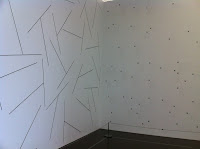ARCHITECTURAL SCRIBBLING AND DRAWINGS
These days I do not make the effort more than once to look at something, an artist’s work or an installation unless it «speaks to me». It’s very rare that an installation does that. Sol Lewitt’s work which I discovered in New York - was it in the 80’s? - didn’t at all. I have never made an effort to go and see his wall paintings as I didn’t see the point. Laurent and Jerome would call them wall scribbles....and yet are they?
This is an unprecedented retrospective in Europe of Sol LeWitt’s work (1928-2007).
This comes from the Pompidou Metz home page relating to the exhibition.
I was still indifferent and yet virtually alone in this vast space. Something touches you- but what ? Geometrical designs in black and white on walls in different spaces ? Sometimes coloured geometrical designs ? There is something mighty about this work but I still couldn’t understand what.
Then I discovered a documentary made by the centre on how the wall paintings were completed. A group of 60 or more students and official people from the artist’s ateliers work on the original Sol Lewitt architectural designs and follow them to paint or draw on the different walls in the gallery. Like a building, every design is adapted to the space, adapted to the wall and if the students make a mistake it is integrated into the wall paintings as such. Each one of those spots, crosses, scribbles is calculated....each line measured, each text placed where the student felt it should be. It took over two months to complete. An extraordinary achievement and yes, in a way, an artistic feat.
I wont make the effort to see his work again, but now I understand a little better what it is all about and how much effort is needed to achieve the end result. A result which is different every time....
This is an unprecedented retrospective in Europe of Sol LeWitt’s work (1928-2007).
This comes from the Pompidou Metz home page relating to the exhibition.
"In the 13,000 square feet of Galerie 2, the Centre Pompidou-Metz is hosting a retrospective of Sol LeWitt's wall drawings on a scale never seen before in Europe. The selected thirty-three wall drawings, the largest group ever exhibited in Europe, span the artist's career from its beginnings to his final works.I read this before I went the other day. It left me quite indifferent. Nothing to do with the «Mathematical Discovery» at the Cartier Foundation with Laurent on the 22nd January. But I was there so after the four hours in «1917» and the moment of pleasure with Buren, I went up to the 2nd floor.
Chosen from the 1,200 wall drawings which LeWitt created between 1968 and 2007, they reflect both the extraordinary consistency of his systematic explorations - with rigorous sets and combinations of geometric elements - and the remarkable diversity of his practice, both in the evolution of forms from simple geometric figures to what the artist called "complex" or "continuous" forms, and of the materials used (from pencil and crayon to ink washes, acrylic paint and graphite).
Through a remarkable partnership with local schools of art and architecture, the execution of these wall drawings at the Centre Pompidou-Metz fully conveys the spirit of collaboration and generosity advocated by the artist."
I was still indifferent and yet virtually alone in this vast space. Something touches you- but what ? Geometrical designs in black and white on walls in different spaces ? Sometimes coloured geometrical designs ? There is something mighty about this work but I still couldn’t understand what.
Then I discovered a documentary made by the centre on how the wall paintings were completed. A group of 60 or more students and official people from the artist’s ateliers work on the original Sol Lewitt architectural designs and follow them to paint or draw on the different walls in the gallery. Like a building, every design is adapted to the space, adapted to the wall and if the students make a mistake it is integrated into the wall paintings as such. Each one of those spots, crosses, scribbles is calculated....each line measured, each text placed where the student felt it should be. It took over two months to complete. An extraordinary achievement and yes, in a way, an artistic feat.
I wont make the effort to see his work again, but now I understand a little better what it is all about and how much effort is needed to achieve the end result. A result which is different every time....
 |
| First gallery |
 |
| Third |
 |
 |
 |






Commentaires